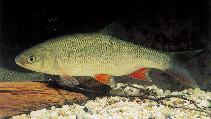Uploaden van uw Foto's en video's
Pictures | Videos | Google afbeeldingLeuciscus idus
Picture by Zienert, S.
Pictures | Videos | Google afbeeldingLeuciscus idus
Picture by Zienert, S.
Common names from other countries
Classificatie / Names Lokale namen | Synoniemen | Catalog of Fishes(Genus, Soort(en)) | ITIS | CoL | WoRMS | Cloffa
> Cypriniformes (Carps) > Leuciscidae (Minnows) > Leuciscinae
Etymology: Leuciscus: Greek, leykiskos = white mullet (Ref. 45335).
More on author: Linnaeus.
Etymology: Leuciscus: Greek, leykiskos = white mullet (Ref. 45335).
More on author: Linnaeus.
Environment: milieu / climate zone / depth range / distribution range Ecologie
; zoet water; brak water benthopelagisch; pH range: 7.0 - 7.5; dH range: 10 - 15; potamodroom (Ref. 51243); diepte 15 - ? m (Ref. 5732). Temperate; 4°C - 20°C (Ref. 1672); 73°N - 37°N, 7°E - 136°E
Verspreiding Landen | FAO regio's | Ecosystemen | Voorkomen | Point map | Introducties | Faunafri
Europe and Asia: Baltic, Black, northern Caspian and North Sea basins, Atlantic basin southward to Seine and lower Loire drainages (France). Absent in Scandinavia north of 69°N. In Asia, eastward to Lena drainage and Aral basin. Introduced to Great Britain and northern Italy (Ref. 59043). Transported to several countries in Europe and the United States for ornament (Ref. 4537).
Lengte bij maturiteit / Grootte / Gewicht / Leeftijd
Maturity: Lm ? range ? - ? cm
Max length : 85.0 cm SL mannelijk / geslacht onbekend; (Ref. 59043); common length : 30.0 cm TL mannelijk / geslacht onbekend; (Ref. 556); max. gepubliceerd gewicht: 4.0 kg (Ref. 556); max. gerapporteerde leeftijd: 29 Jaren (Ref. 126842)
Max length : 85.0 cm SL mannelijk / geslacht onbekend; (Ref. 59043); common length : 30.0 cm TL mannelijk / geslacht onbekend; (Ref. 556); max. gepubliceerd gewicht: 4.0 kg (Ref. 556); max. gerapporteerde leeftijd: 29 Jaren (Ref. 126842)
Korte beschrijving Determinatiesleutels | Morfologie | Morfometrie
Dorsale stekels (totaal) : 3; Dorsale zachte stralen (totaal) : 8 - 11; Anale stekels: 3; Anale zachte stralen: 8 - 11; Wervels: 47. Diagnosed from congeners in Europe by the following characters: lateral line with 56-58 + 3 scales; pharyngeal teeth 3,5-5,3; mouth terminal; dorsal fin with 8½ branched rays; anal fin with 10-11½ branched rays; all fins except dorsal fin with reddish tinge; pigmentation on lateral scales lacking regular black mesh (Ref. 59043). Caudal fin with 19 rays (Ref. 2196).
Usually inhabits large lowland rivers and nutrient-rich lakes. Adults are solitary while juveniles are gregarious. Undertakes migration to tributaries to spawn in moderate current on gravel or submerged vegetation. Feeds on various aquatic and terrestrial animals and plant material. Larger individuals feed mainly on fishes. Feeding larvae and juveniles thrive in a wide variety of shoreline habitats and leave the shores for deeper waters when growing. Reported to sometimes hybridizes with Aspius aspius (Ref. 59043). Its flesh is not tasty (Ref. 30578). Aquarium keeping: at least 10 individuals; minimum aquarium size >200 cm; not recommended for home aquariums (Ref. 51539).
Levenscyclus en paargedrag Maturiteit | Voortplanting | Paaien | Eieren | Fecunditeit | Larven
"Females spawn only once each season. Individual females spawn with several males. Males assemble at spawning grounds and follow ripe females. Females attach the sticky eggs to gravel or submerged plant material" (Ref. 59043).
Hoofdreferentie
Upload your references | Referenties | Coördinator | Medewerkers
Kottelat, M. and J. Freyhof, 2007. Handbook of European freshwater fishes. Publications Kottelat, Cornol and Freyhof, Berlin. 646 pp. (Ref. 59043)
Status op de Rode Lijst van het IUCN (Ref. 130435: Version 2024-2)
Niet bedreigd (LC) ; Date assessed: 22 October 2023
Gevaar voor de mens
Harmless
Gebruik door de mens
Visserij: commercieel; sportvis: ja; Aquarium: Commercieel
FAO(Aquaculture systems: productie; visserij: productie; publication : search) | FishSource | Sea Around Us
Meer informatie
Population dynamics
Groeiparameters
Max. ages / sizes
Length-weight rel.
Length-length rel.
Lengtefrequenties
Massaconversie
Rekrutering
Abundantie
Groeiparameters
Max. ages / sizes
Length-weight rel.
Length-length rel.
Lengtefrequenties
Massaconversie
Rekrutering
Abundantie
Life cycle
Voortplanting
Maturiteit
Fecunditeit
Paaien
Spawning aggregations
Eieren
Ontwikkeling van de eieren
Larven
Larvale populatiedynamiek
Voortplanting
Maturiteit
Fecunditeit
Paaien
Spawning aggregations
Eieren
Ontwikkeling van de eieren
Larven
Larvale populatiedynamiek
Anatomy
Kieuwoppervlak
Brain
Otolith
Kieuwoppervlak
Brain
Otolith
Physiology
Body composition
Nutrients
Zuurstofverbruik
Zwemtype
Zwemsnelheid
Visual pigments
Fish sound
Diseases & Parasites
Toxicity (LC50s)
Body composition
Nutrients
Zuurstofverbruik
Zwemtype
Zwemsnelheid
Visual pigments
Fish sound
Diseases & Parasites
Toxicity (LC50s)
Human related
Aquaculture systems
Aquacultuurprofielen
Kweeklijnen
Ciguatera cases
Stamps, coins, misc.
Aquaculture systems
Aquacultuurprofielen
Kweeklijnen
Ciguatera cases
Stamps, coins, misc.
Tools
Bio-Quiz | E-boek | Veldgids | Determinatiesleutels | Lengtefrequentie Tool | Levenscyclus tool | Verspreidingskaart | Classification Tree
| Catch-MSY |
Speciale rapporten
Bekijk gegevens voor het houden in een aquarium | Bekijk Fact Sheets voor de soort | Bekijk Aquacultuur Fact Sheets
Download XML
Internetbronnen
Exoten/Invasieve soorten database | Aquatic Commons | BHL | Cloffa | Websites from users | Bekijk FishWatcher | CISTI | Catalog of Fishes(Genus, Soort(en)) | DiscoverLife | DORIS | ECOTOX | Faunafri | Fishtrace | GenBank(genoom, nucleotide) | GloBI | GOBASE | | Google Books | Google Scholar | Google | IGFA World Record | MitoFish | Nationale databanken | Otolith Atlas of Taiwan Fishes | Publieke aquaria | PubMed | Reef Life Survey | Scirus | SeaLifeBase | Tree of Life | Wikipedia(ga naar, zoek) | World Records Freshwater Fishing | Zoological Record
Estimates based on models
Fylogenetische diversiteitsindex (Ref. 82804): PD50 = 0.5000 [Uniqueness, from 0.5 = low to 2.0 = high].
Bayesian length-weight: a=0.00589 (0.00484 - 0.00717), b=3.15 (3.12 - 3.18), in cm Total Length, based on LWR estimates for this species (Ref. 93245).
Trofisch niveau (Ref. 69278): 3.8 ±0.59 se; based on food items.
Weerstandsvermogen (Ref. 120179): laag, minimale populatieverdubbelingstijd 4,5-14 jaar (tm=5-9).
Fishing Vulnerability (Ref. 59153): High to very high vulnerability (69 of 100).




